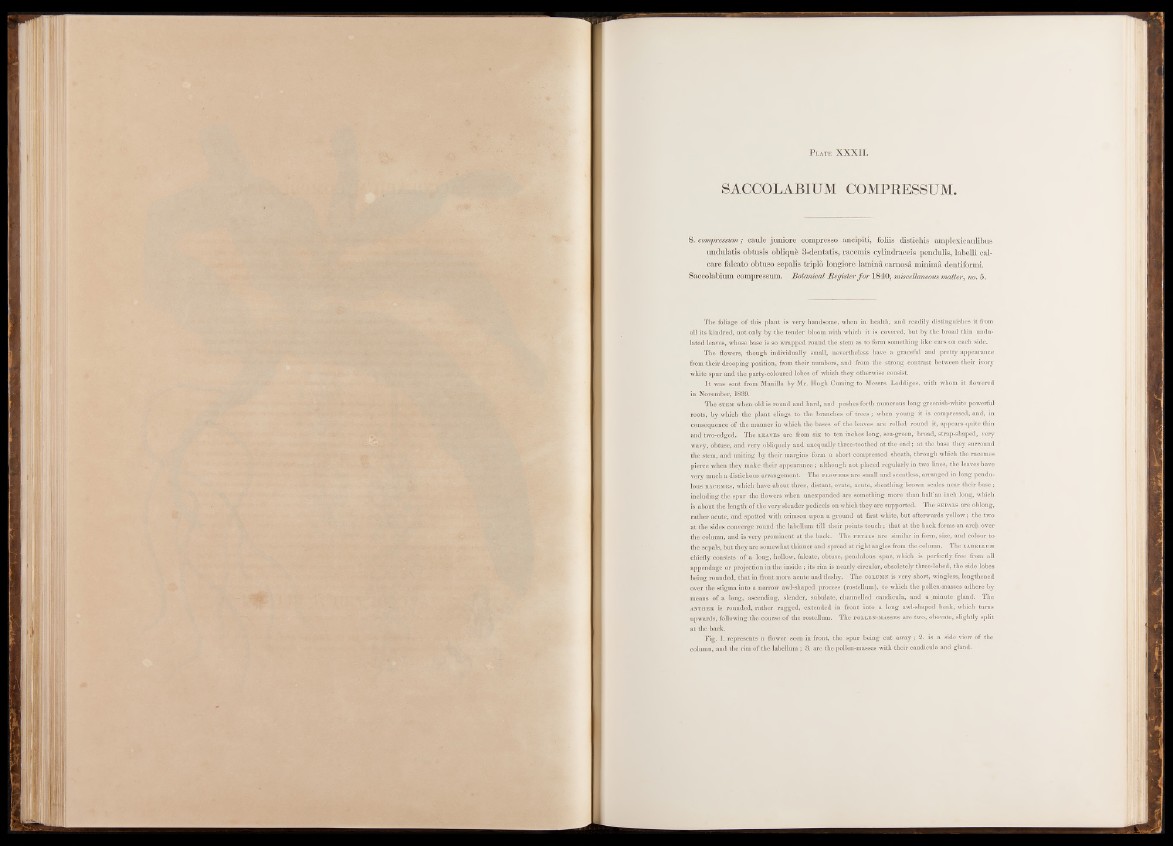
SACCOLABIUM COMPRESSUM,
S. compressum ; caule juniore compresso ancipiti, foliis distichis amplexicaulibus
undulatis obtusis obliqué 3-dentatis, racemis cylindraceis pendulis, labelli cal-
care falcato obtuso sepalis triplé longiore laminâ camosâ minimâ dentiformi.
Saccolabium compressum. Botanical Register fo r 1840, miscellaneous matter, no. 5.
The foliage of this plant is very handsome, when in health, and readily distinguishes it from
all its kindred, not only by the tender bloom with which it is covered, but by the broad thin undulated
leaves, whose base is so wrapped round the stem as to form something like ears on each side.
The flowers, though individually small, nevertheless have a graceful and pretty appearance
from their drooping position, from their numbers, and from the strong contrast between their ivory
white spur and the party-coloured lobes of which they otherwise consist.
It was sent from Manilla by Mr. Hugh .Cuming'to Messrs. Loddiges, with whom it flowered
in November, 1839.
The stem when old is round and hard, and pushes forth numerous long greenish-white powerful
roots, by which the plant clings to the branches of trees; when young it is compressed, and, in
consequence of the manner in which the bases of the leaves are rolled round it, appears quite thin
and two-edged. The leaves are from six to ten inches long, sea-green, broad, strap-shaped, very
wavy, obtuse, and very obliquely and unequally three-toothed at the end; at the base they surround
the stem, and uniting by their margins form a short compressed sheath, through which the racemes
pierce when they make their appearance; although not placed regularly in two lines, the leaves have
very much a distichous arrangement. The flowers are small and scentless, arranged in long pendulous
racemes, which have about three, distant, ovate, acute, sheathing brown scales near their base;
including the spur the flowers when unexpanded are something more than half an inch long, which
is about the length of the very slender pedicels on which they are supported. The sepals are oblong,
rather acute, and spotted with crimson upon a ground at first white, but afterwards yellow; the two
at the sides converge round the labellum till their points touch ; that at the back forms an arch over
the column, and is very prominent at the back. The petals are similar in form, size, and colour to
the sepals, but they are somewhat thinner and spread at right angles from the column. The labellum
chiefly consists of a long, hollow, falcate, obtuse, pendulous spur, which is perfectly free from all
appendage or projection in the inside ; its rim is nearly circular, obsoletely three-lobed, the side lobes
being rounded, that in front more acute and fleshy. The column is very short, wingless* lengthened
over the stigma into a narrow awl-shaped process (rostellum), to which the pollen-masses adhere by
means of a long, ascending, slender, subulate, channelled caudicula, and a .minute gland. The
anther is rounded, rather rugged, extended in front into a long awl-shaped beak, which turns
upwards, following the course of the rostellum. The pollen-masses are two, obovate, slightly split
at the back.
Fig. 1. represents a flower seen in front, the spur being cut away; 2. is a side view of the
column, and the rim of the labellum ; 3. are the pollen-masses with their caudicula and gland.